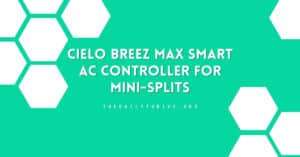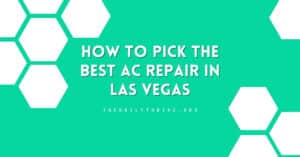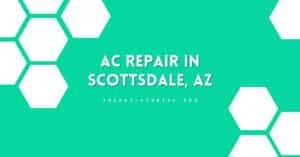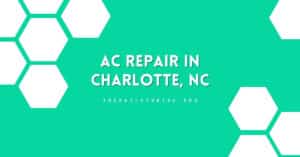Have you ever noticed your lights taking a dramatic dip or dance when you fire up your Air Conditioner? That little flicker is more than just an electrical hiccup—a sign of the massive power surge that hits when your AC kicks into gear. Upon startup, your air conditioning compressor is a power-hungry beast, craving four to eight times more electrical current than during its regular run time, and this is where an AC hard start kit comes into play.
This insatiable appetite for current results in an inrush—a tidal wave of energy—that generates a significant amount of heat. This intense process doesn’t just light up your house; it puts a heavy strain on your central air conditioning’s most critical parts—compressor, terminals, windings, and the run capacitor. AC hard start kits are essential for a smooth operation. Still, they’re not made to handle the heat and stress of such power surges indefinitely.
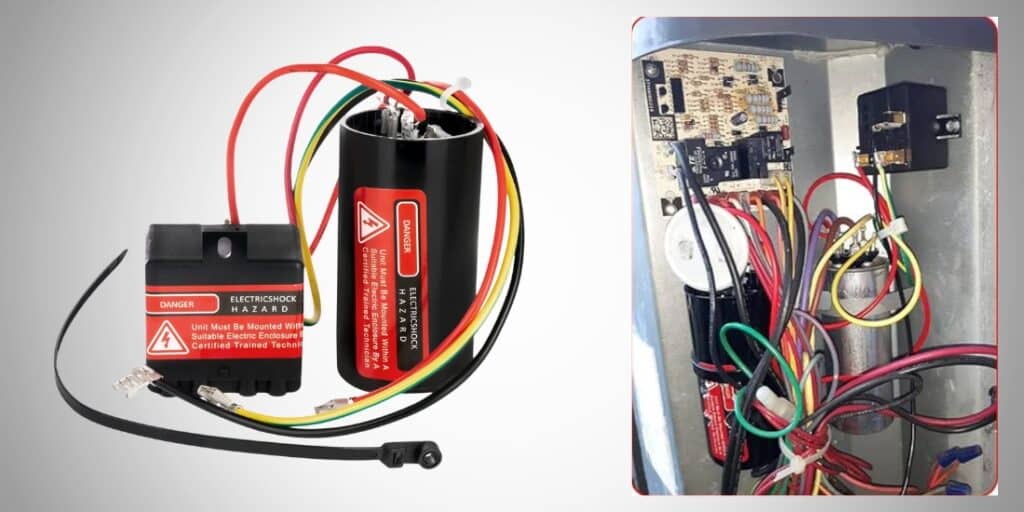
So, what changed? Once upon a time, single-phase air conditioning compressors came with a trusty sidekick—a factory-installed hard start device. These devices were the unsung heroes that shouldered the burden of the initial power surge. However, in a twist of fate, driven by the relentless pursuit of cutting costs (perhaps at the expense of your unit’s longevity), these AC hard start devices were phased out.
Today, most single-phase compressors are left to fend for themselves, resulting in lower starting torque and susceptibility to the wear and tear of hard starts.
Enter the modern-day savior, the aftermarket AC hard start kit. Think of it as the reinforcements arriving just in time to fortify your air conditioner’s startup process. It’s a simple solution, hearkening back to the wisdom of the past, ensuring that your AC can start with less strain and more grace.
In the upcoming sections, we’ll dive into the workings of a hard start kit, its invaluable benefits, and how to tell when your AC is a prime candidate for this essential upgrade.
How an AC Hard Start Kit Works
Alright, let’s get into the nuts and bolts of how an AC hard start kit does its magic. To the uninitiated, it might sound like tech magic, but it’s actually a beautiful blend of physics and engineering ingenuity.
So, what is a hard start kit? It’s a little device that packs a big punch. At its core, a hard start kit is all about giving your AC the extra oomph it needs to start up without drama. It adds crucial starting torque and cleverly kicks itself out of the circuit once the compressor proudly hums along.
Think of a hard start kit as your AC’s personal trainer and life coach rolled into one. It not only preps your AC’s motor for the big start but also ensures it doesn’t overdo it. How does it manage this? By storing energy and then, at the moment of truth, unleashing it to propel the compressor into action. Once the compressor is up and running, the hard start kit gracefully bows out, diverting any excess energy to avoid any internal system shock that could cause damage.
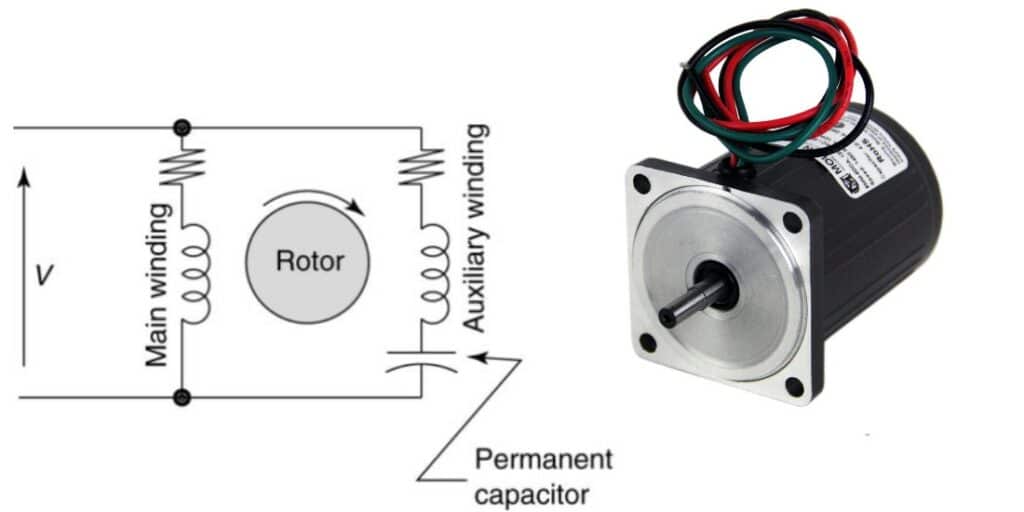
But why do we need this extra torque? Most AC units are equipped with permanent split capacitor (PSC) motors, which, while efficient, don’t boast a lot of torque at startup. And as these compressors age, like a seasoned athlete, they may not start with the same pep. Starting these units can be likened to waking a sleeping giant—it takes a lot of coaxing (read: voltage) and results in a lot of heat. Unfortunately, heat is a notorious enemy of electrical components, leading to wear and tear that shortens the life of your compressor.
Enter the hard start kit.
When installed on the AC compressor, it reduces the electricity required at startup by providing that extra torque. This power reduction draw not only saves energy but spares your compressor the stress of heating up. The relay in the hard start kit is the behind-the-scenes hero that disconnects the start capacitor from the circuit after the compressor starts, preventing unnecessary power consumption and heat generation. This means your unit operates efficiently without the extra load on its shoulders.
To visualize it, imagine a top-angled view of an outdoor AC unit. There’s the capacitor, quietly sitting there, waiting for its moment. When the AC is turned on, the hard start kit jumps into action, the energy stored in the capacitor surges into the compressor, and voila—the unit starts with ease. Once the compressor reaches operational speed, the relay clicks, the capacitor steps back, and your AC runs as smoothly as a river flowing downstream.
The hard start kit is like a best friend for your AC—it’s there during the hard times (the startup). Then, it steps back when it’s no longer needed, ensuring a long-lasting, healthy life for your air conditioner or heat pump. It’s a straightforward upgrade that can make a world of difference in the longevity and efficiency of your HVAC system.
Types of AC Hard Start Kits
1. Mechanical Potential Relay Hard Start Kit
This is the most common type of hard start kit. It uses a potential relay to remove the start capacitor on the circuit once the AC compressor is approximately 75% to 80% of its full operating speed.
It works when the compressor’s rotor generates the back EMF (electromotive force) to open the relay to take the start capacitor from the start circuit.
Once the compressor ceases to operate, it is ready for the next cycle; no time for cool-down is needed.
2. PTC Hard Start Kits
PTC hard start kits use a ceramic element to remove the start capacitor from the circuit upon unit start-up instead of using a potential relay.
This works like the first type, but instead of the EMF opening the relay and removing the start capacitor, the ceramic element heats up to 250 degrees, opens the circuit, and takes the start capacitor out. Because of the heat generated, PTC hard start devices need downtime to cool down for 2 to 3 minutes before being effectively used again.
PTC hard start kits also do not have intelligent sensing ability. Unlike Mechanical Potential Relay Hard Start Kits, PTC may have the start capacitor stay longer. Even though the compressor has already started or prematurely takes the start capacitor out even before the AC capacitor starts.
Benefits of Installing an AC Hard Start Kit
When you think about the benefits of a hard start kit, it’s all about the health and wealth of your home’s cooling system. Here’s why you should seriously consider giving your AC this power-boosting companion:
- Energy Efficiency and Cost Savings: By smoothing out the starting process, a hard start kit reduces the initial power draw. This means less energy consumed and, consequently, lower energy bills. It’s like teaching your AC to start its day with a gentle stretch instead of a full-on sprint. Over time, those saved kilowatt-hours add to a more budget-friendly energy statement.
- Extended Compressor Life: Your compressor is the heart of your AC, and just like any heart, it doesn’t take kindly to stress. A hard start kit minimizes the stress on your compressor by lowering the starting torque required. This gentle start can help prevent common issues such as overheating and tripped breakers, which are not just nuisances but also potential death sentences for compressors. By lessening the load, you’re effectively adding years to your compressor’s lifespan, delaying the need for a costly replacement.
- Reduced Wear and Tear: Every time your AC starts up without a hard start kit, it’s like hitting the gas pedal hard in your car—it’s jarring and wears out the engine faster. The kit acts as a shock absorber, cushioning the blow and making for a softer start. This protection against wear and tear translates to fewer service calls, fewer replacement parts, and more money in your pocket.
- Quieter Operation: An AC struggling to start can be noisy, with a tell-tale clunk or a grinding noise as unpleasant as nails on a chalkboard. With a hard start kit, the start-up is smoother, which means quieter operation. It’s the difference between a gentle hum and a loud bang. Peace and quiet are underrated benefits that make your living space more comfortable.
- Prevents Light Flickering: No more will you have to wonder if the flickering lights are a sign of your home’s haunted past. The hard start kit reduces the power surges that cause these spooky flickers, ensuring your lights stay steady and your home feels more serene.
- Ease of Installation: Compared to other AC upgrades, hard start kits are relatively easy and inexpensive to install. Most HVAC professionals can add them quickly to your existing system, making it a simple, one-and-done improvement that goes a long way in enhancing performance.
- Overall Home Comfort: Last but not least, a well-functioning AC equates to a comfortable home. With a hard start kit, your air conditioner doesn’t just work better; it works smarter. This means consistent temperatures, less humidity, and a general feeling that all’s right in your domestic world.
In essence, a hard start kit is not just an accessory; it’s an investment in the efficacy and longevity of your AC system. It’s a small tweak that brings about significant benefits, making it a smart choice for homeowners looking to optimize their home comfort systems.
When You Need an AC Hard Start Kit
Knowing when to equip your air conditioner with a hard start kit can save you from future headaches and unexpected repair costs.
If you’ve ever been vexed by your air conditioner’s refusal to start without a struggle, you’re already acquainted with hard starting. This troublesome condition means your AC huffs and puffs to get going and can indicate that your unit is aging. Not only is it inconvenient, but hard starting can also be the harbinger of future breakdowns.
The Phenomenon of Hard Starting: This is when your air conditioner labors to turn on, stuttering as it tries to start, then abruptly shuts off. It’s as though your AC is trying to ignite a spark within but just can’t keep the flame alive. Hard starting strains every sinew of your unit’s system and, over time, can inflict serious wear and tear on the compressor and other vital components.
Here’s how to spot the tell-tale signs that your AC unit could benefit from this little powerhouse of a solution:
Your AC Stops and Starts Frequently (Short Cycling)
Picture this: you’re enjoying a quiet afternoon, and your AC kicks on, only to give up the ghost a few moments later. This frustrating phenomenon is known as short cycling. It’s akin to your unit being caught in a loop, struggling to push past the start line. This not only saps energy but also wreaks havoc on the compressor, accelerating wear and tear. A hard start kit gives your unit the extra oomph to break free from this cycle and run smoothly.
The Dreaded Clicking Noise
When you hear a persistent clicking from the compressor, it’s not tapping out a merry tune—it’s screaming for help. This sound often indicates that the compressor is overexerting itself, trying (and failing) to muster the power to start up the unit. This excessive power draw is a recipe for rapid system degradation. Still, a hard start kit can turn the tide, providing the necessary power without the strain.
Tripping Circuit Breakers
It’s a bad sign when your circuit breaker trips every time your AC starts up. This is your home’s electrical system putting up the white flag, unable to handle the power demands of a struggling AC compressor. Rather than resetting the breaker repeatedly (and crossing your fingers each time), a hard start kit can resolve the underlying issue, ensuring a smoother start-up that keeps the peace with your circuit breaker.
The Flickering Light Show
Flickering lights can set the stage for a cozy movie night. Still, when they’re a side effect of your AC starting up, it’s less about ambiance and more about an electrical SOS. Dramatic flickering signals that the power surge from the AC start-up is too much for your home to handle gracefully. By moderating the initial power draw, a hard start kit can keep the flickering to a minimum, stabilizing your home’s electrical flow.
If you’re nodding along, recognizing these symptoms in your AC unit, it might be time to consider a hard start kit. In doing so, it extends the unit’s life span, maintains energy efficiency, and enhances overall performance. Before you call in the professionals, take note of these symptoms so you can give them a clear picture of why you believe a hard start kit is necessary for your system.
Who Should Invest in an AC Hard Start Kit?
Navigating the world of air conditioning can feel like decoding a complex weather pattern. For the uninitiated, let’s break it down. Single-stage air conditioners are like light switches—fully on or completely off. In contrast, variable-speed models are the dimmers of the AC world, adjusting their output gracefully from a gentle 35% to a full-blown 100% depending on various temperature cues from inside and out.
Here’s the straightforward advice: A hard start kit should be a non-negotiable add-on for every newly purchased heat pump and single-stage air conditioner. Think of it as a small investment now for smoother operation.
Cost of Installing an AC Hard Start Kit
When it’s time to integrate a hard start kit into your system, anticipate an investment of about $300 to $350, encompassing both the hardware and installation labor. Comparatively, it’s a drop in the bucket against the staggering $2,500 or more you’d fork out for a new compressor.
Evaluating AC Replacement Versus Retrofitting
If your AC is a seasoned player in the cooling game, it might have a built-in hard start kit. If not, installing one might be the savvy short-term fix to keep your space chill. But let’s talk longevity and economics. When the compressor starts showing its age, replacing it might not be the most economical move—you’d likely be shelling out cash equivalent to the value of your old unit.
So, whether you’re eyeing an AC hard start kit as a strategic investment for a new AC or as a lifeline for an older unit, weigh the costs, consider the benefits, and remember: Your comfort is the ultimate bottom line.


